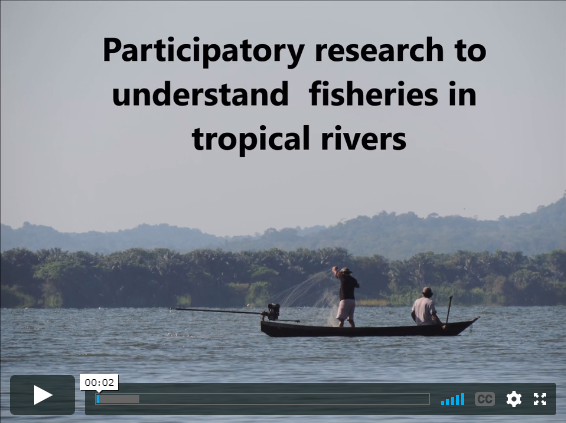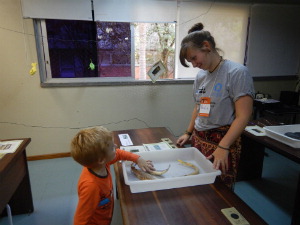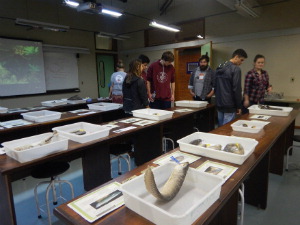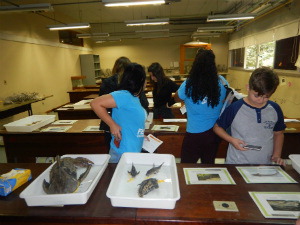|
Cycle 4 (2015 Deadline)
Linking sustainability of small-scale fisheries, fishers’ knowledge, conservation and co-management of biodiversity in large rivers of the Brazilian Amazon
PI: Renato Silvano (renato.silvano@ufrgs.br), Federal University of Rio Grande do Sul (UFRGS)
U.S. Partner: Kirk Winemiller, Texas A&M AgriLife Research
Project Dates: October 2015 - June 2018
Project Page in ResearchGate
Project Overview  | | The above video was presented at the Innovations in STEM Education video showcase in May 2019. |
The occurrence and efficacy of local co-management initiatives to promote biodiversity conservation or sustainable use of natural resources are largely unknown for most of the Brazilian Amazon, especially in the less productive black and clear water rivers. This project will take a multidisciplinary approach through an integrated analysis of fishers’ local ecological knowledge, fishing dynamics, and fish ecology to evaluate potential ecological and socioeconomic outcomes of co-management systems in clear and black water rivers. The researchers will address the following main research questions: (1) Do fishing communities that are organized in some form of co-management system (for example, inside extractive reserves) have higher fishing yields, abundance of fish, and fish diversity? (2) Do the outcomes and problems related to co-management differ between clear and black water rivers? (3) How do fishing intensity and co-management influence the abundance of frugivorous and detritivorous fishes and their functional roles in these two river systems? (4) Does fishers’ knowledge provide data about temporal trends on fish abundance, fish ecology, and main fish species caught that support fishers’ food security? Dr. Silvano and his team will study four fishing communities inside and four outside Extractive Reserves (RESEX) in the clear water Tapajós River and in the black water Negro River, and all results will be compared between these two rivers and between communities with (inside the RESEX) and without (outside the RESEX) established co-management systems. The collaboration with the U.S. partner and his group will complement the project goals regarding fish ecology; comparison of fish abundance, composition, and diversity among fishing communities and between rivers; and analysis of the structure of fish communities. The planned analysis should improve understanding on potential drivers (ecological or economic) of unsustainable fishing practices that undermine conservation efforts.
The results of this research will provide invaluable empirical information currently lacking to promote governance and guide conservation policies aimed at Amazonian aquatic ecosystems. The project team’s results should help policy makers, government technicians, and natural resource managers to devise measures to alleviate the environmental pressures and to reconcile biodiversity conservation with fisheries sustainability. Findings from this project will be transferred to managers of the two studied Extractive Reserves, and the local communities will be information about project results during a workshop at the end of project and through publication of a book for laypersons. The knowledge and training to be provided to fishers, the participation of managers from the Brazilian Institute of Biodiversity Conservation, and the possible engagement of local associations could allow the continuity of resource monitoring and improvement of management activities after this project ends. This research should thus enhance the resilience of the studied communities by building capacity of local people to manage their resources, to negotiate with other stakeholders, and to cope with future changes in resources or the environment, such as dams or climatic alterations affecting the flooding regime.
Final Summary of Project Activities
During this project, which was completed at the end of June 2018, the PI Dr. Silvano and his team made nine fieldtrips (four to the Rio Negro and five to the Tapajos) to gather data on fish and fisheries and to organize meetings with people from the communities participating in the research. They carried out 64 collections of fish, 32 in each river, corresponding to two samples in each of the eight studied communities in each river during two seasons (high and low water). All told they collected and measured 12,437 individual fish in both rivers, some of which were brought to their lab to be identified and to be preserved as voucher specimens. Although the final number of fish species should be confirmed soon after being double-checked by an ichthyologist specialist on Amazon fishes, as of September 2018 the researchers had already confirmed the occurrence of 192 fish species, 111 species in the Tapajos and 144 species in the Negro (some fish species occur in both rivers). During the fieldtrips the team also took more than 2,000 photos of individual fish of all collected species, to record them with their live, natural coloration. These data will be part of a book that Dr. Silvano and his colleagues are compiling, to be published by Springer later in 2018. Data on the fish sampled will provide information about the occurrence and abundance of fish species that are important for commercial or food purposes, besides allowing comparisons of fish abundance among communities located inside and outside the extractive reserves. Fish samplings could also provide useful data about some fish biological parameters, such as length-weight relationships, which can be included in fisheries modeling. These biological data are currently scarce for most fish species from the Amazon Basin, especially in less studied clear and black water rivers.
In addition to collecting samples themselves, the project team also implemented a participatory monitoring program in which some fishers voluntarily recorded their fish landings five days per month over a twelve-month period from July 2016 to June 2017 in the Tapajos and from August 2016 to July 2017 in the Negro. A total of 130 fishers from both rivers participated in this monitoring activity, recording 3,760 fish landings in total that were suitable for analyses (after excluding incomplete or inaccurate data). These data on fish landings provide information about fishing effort, fish species most exploited for food or sale, fish sizes, and spawning activity for some fish species, among other information. During this voluntary monitoring, each fisher entered his or her data on paper forms that were later collected by the researchers. This process helped to involve more fishers in the research and provided some capacity building among the studied communities. However, participation was variable, as not all fishers were able to record their fish landings consistently and diligently on a voluntary basis. Another caveat of this method was the long time and continuous effort required to collate and digitize all data recorded by fishers. To address this issue, Dr. Silvano and his colleagues also conducted a pilot project on monitoring of fisheries by data collectors in each studied community who recorded data on mobile phones through the ODK technology. This pilot project was conducted in three communities of the Tapajos River during three months and showed promising results. The ODK monitoring seems to present a promising option for recording fish landings in remote communities and in a faster way, as it does not require paper and data could be readily downloaded to a worksheet. Therefore, the project helped both the researchers and participating people from the involved communities to develop and to improve their knowledge and skills regarding monitoring of use of natural resources.
The project also involved a considerable volume of interviews with members of local fishing communities. The researchers made a total of 565 interviews in 16 communities on the Tapajos and the Negro in the original project, plus 171 more in a pilot add-on activity, expanding the research to the protected area located on the opposite bank of the Tapajos (National Forest) and to communities located along the banks for approximately 150 km further upstream, as far as the community of São Luiz do Tapajos and the city of Itaituba. These interviews addressed several aspects of fishers’ knowledge, environmental changes, fishing dynamics, and socioeconomic issues. The complete database of interview responses could facilitate comparisons not only among communities located inside and outside the protected area, but also along a longitudinal gradient on the Tapajos, which might be useful to evaluate potential future impacts of planned dams to be built upstream, near São Luiz do Tapajos.  |  |  | | Outreach activity held at an open day at Federal University of Rio Grande do Sul (UFRGS), May 20, 2017 (photo credit: Dr. Silvano) |
Based on their interviews and other data, the project team produced 155 GIS-based maps indicating locations of spawning sites, migration routes, and preferred fishing grounds of selected fish species according to fishers’ knowledge. These maps (104 at the community scale, 12 for the entire river, and 39 aggregating data for each studied fish) could be useful to identify and hence protect important habitats for fish reproduction, especially in co-management initiatives at the community level. The researchers also collected and compiled actual and estimated fish size measurements, which could be used to evaluate fishing pressure and the health of fish stocks in the studied rivers. In addition, they collaborated with their U.S. partner’s lab to conduct stable isotope analysis of more than 140 fish tissue samples, with more than 200 others still being processed. These analyses should support at least two papers in collaboration with the U.S. partner.
In addition to 21 meetings with the studied fishing communities, Dr. Silvano and his team met three times with Brazilian government officials in charge of the management of protected areas where people reside, such as the two studied Extractive Reserves. During these meetings they highlighted their PEER project results and suggested potential applications to address current problems affecting local fisheries or to support management initiatives. As of September 2018, the PI and his research team had made 31 presentations (oral or poster) on their PEER results in in six countries, and they organized a photo exhibit on their Amazon exhibitions that has been shown in Porto Alegre, Brasilia, Tampa, and Halifax. On the education side of the project, PEER funds supported the successful completion of four MSc. dissertations through the Post Graduate Program in Ecology at UFRGS. These include (1) Small-scale fisheries of frugivorous fish in clear and black water rivers of the Brazilian Amazon, by Paula Nagl (August 2017); (2) Influences of fishing pressure and protected areas on fish communities in two tropical rivers, by Pedro P. Nitschke (May 2018); (3) Fishers’ knowledge identifies potential socio-ecological impacts downstream of proposed dams in the Tapajós River, Brazilian Amazon, by Anne Runde (November 2018); and (4) Interactions between fishes, fishermen, and ecosystem services in black and clear water rivers of the Brazilian Amazon Basin, by Astrid Tatiana Romero Martinez at the Pontificia Universidad Javeriana in Bogota, Colombia (March 2019).
Now that his PEER funding has ended, the PI and his colleagues and students are continuing their work with support from two other funders. A grant from the Social Sciences Humanities Research Council of Canada is funding a project entitled “Tracking Change - The Role of Local and Traditional Knowledge in Watershed Governance.” Small additional grants from the Postgraduate Program in Ecology of the Federal University of Rio Grande do Sul (UFRGS) are supporting the research of graduate students linked to the research work on the Tapajos River. Citations and links for three papers published so far in 2020 are available above. Links to several recent video presentations by some of Dr. Silvano's graduate students (in Portuguese) are posted below.
Comparação da composição de pescado entre relatos de pescadores e dados de desembarques na Amazônia (author: Ivan Alves)
Mapeamento participativo como indicador de importantes regiões para a pesca e desova de peixes no Baixo Rio Tapajós, Amazônia Brasileira (author: Kaluan Calini Vieira)
Diferenças do pescado vendido e consumido dos rios Negro e Tapajós, Amazônia Brasileira (author: Jaqueline Zanini)
Comparação da eficiência de pesca segundo entrevistas com pescadores em três rios de águas claras da Amazônia (author: Luís Henrique Tomazoni da Silva)
Pesca nas redes sociais: Construindo uma ponte entre o conhecimento tradicional e população geral (author: Márcia Caroline Friedl Dutra)
Publications Pereyra, P.E.R., Ospina‑Alvarez, A., Dutra, M.C.F. et al. 2024. Integrating fishers’ knowledge on fish use with ecological networks to assess the ‘silent threat’ of mercury contamination in tropical marine and freshwater fisheries. Environment, Development, and Sustainabilty. https://doi.org/10.1007/s10668-024-04990-y
Hallwass, G., Keppeler, F.W., Tomazoni-Silva, L.H. et al. 2023. ‘Disentangling’ the advantages from gillnets in freshwater small-scale fisheries in the Brazilian Amazon. Rev Fish Biol Fisheries. https://doi.org/10.1007/s11160-023-09771-w
Pereyra, P.E.R., G. Hallwass, A. Begossi, L.L. Giacomin, and R.A.M. Silvano. 2023. Fishers’ knowledge reveals ecological interactions between fish and plants in high diverse tropical rivers. Ecosystems (2023). https://doi.org/10.1007/s10021-023-00818-4
Chuctaya, J., P. Nitschke, M.C. Andrade, J. Wingert, and L.R. Malabarba. 2022. A new species of Geophagus (Teleostei: Cichlidae): Naming a cichlid species widely known in the aquarium hobby as ‘Geophagus sp. Tapajos red head.’ J Fish Biol 2022, 1-17. https://doi.org/10.1111/jfb.15207
Policy Brief: The time is now: preserving the ecosystems, fisheries, and cultural heritage of the Amazonian rivers (in English). 2022.
Policy Brief: A hora é agora: preservando os ecossistemas, a pesca e o patrimônio cultural dos rios Amazônicos (em português). 2022.
Silvano, R.A.M., P.E.R. Pereyra, A. Begossi , and G. Hallwass. 2022. Which fish is this? Fishers know more than 100 fish species in megadiverse tropical rivers. FACETS 7: 988–1007. https: doi.org/10.1139/facets-2021-0136.
Nagl, Paula, Gustavo Hallwass, Luis H. Tomazoni-Silva, Pedro P. Nitschke, Anais R.P. Rowedder, Astrid Tatiana Romero-Martinez, and Renato A.M. Silvano. 2021. "Protected areas and frugivorous fish in tropical rivers: Small-scale fisheries, conservation and ecosystem services." Aquatic Conservation: Marine and Freshwater Ecosystems, 1–20. https://doi.org/10.1002/aqc.3673.
Silvano, Renato A.M., Anne Runde, and Gustavo Hallwass. 2021. "Go with the flow: dams could have a far-reaching impact on fisheries in tropical rivers." The Science Breaker, March 29, 2021. https://doi.org/10.25250/thescbrk.brk502
Silvano, Renato A.M. (ed.). 2020. Fish and fisheries in the Brazilian Amazon: People, ecology, and conservation in black and clear water rivers. Springer International Publishing. (Book flyer) https://www.springer.com/br/book/9783030491451
Keppler, F.W., G. Hallwass, F. Santos, L.H. Tomazzoni da Silva, R.A.M. Silvano. 2020. "What makes a good catch? Effects of variables from individual to regional scales on tropical small-scale fisheries." Fisheries Resources 229 (2020):105571. https://doi.org/10.1016/j.fishres.2020.105571
Runde, A., G. Hallwass, and R.A.M. Silvano. 2020. "Fishers' knowledge indicates extensive socioecological impacts downstream of proposed dams in a tropical river." One Earth 2:1-14. https://doi.org/10.1016/j.oneear.2020.02.012
Silvano, R.A.M., and G. Hallwass. 2020. "Participatory research with fishers to improve knowledge on small-scale fisheries in tropical rivers." Sustainability 2020, 12(11):4487. https://doi:10.3390/su12114487
Back to PEER Cycle 4 Grant Recipients
|







